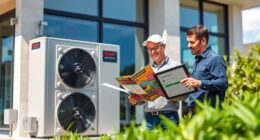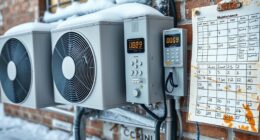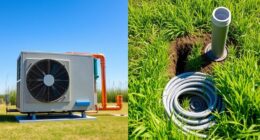Heat pumps naturally dehumidify indoor air during cooling by drawing moisture as they lower the temperature of cold evaporator coils, which causes humidity to condense and drain away. They handle moderate dehumidification well, especially in “dry mode,” which runs at lower speeds for targeted moisture removal without changing the temperature. Proper system design, insulation, and regular maintenance help maximize their performance. Continue exploring to discover how to optimize your heat pump’s moisture control even further.
Key Takeaways
- Heat pumps dehumidify by passing indoor air over cold evaporator coils, condensing moisture for removal.
- They often use a “dry mode” to target moisture without changing indoor temperature.
- Proper system design and maintenance enhance dehumidification efficiency in heat pumps.
- External conditions, like outdoor humidity and temperature, influence their moisture removal effectiveness.
- Combining heat pumps with dedicated dehumidifiers can optimize indoor humidity control, especially in high humidity conditions.
How Heat Pumps Dehumidify During Cooling Mode
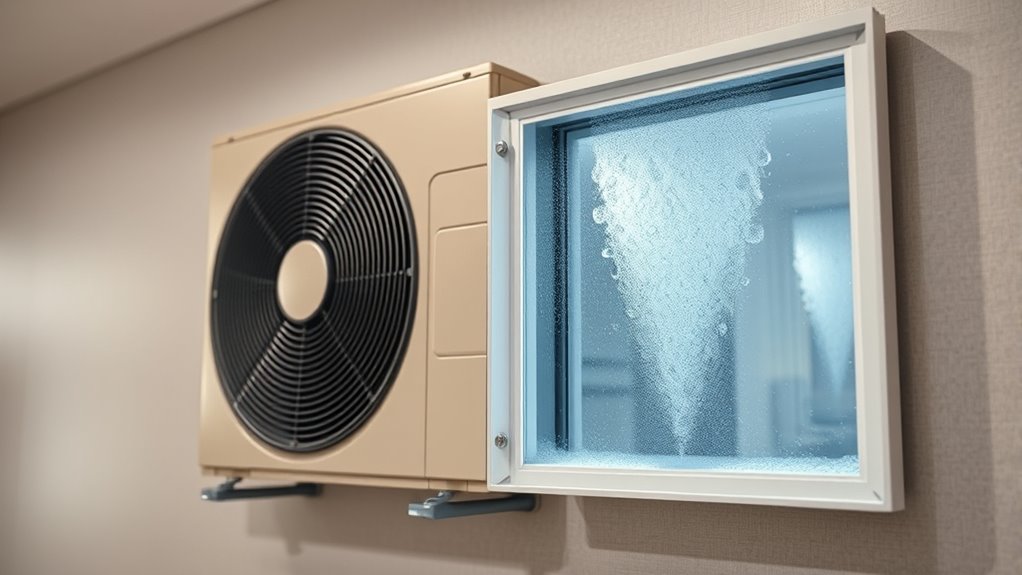
During cooling mode, heat pumps dehumidify by passing indoor air over cold evaporator coils. As warm, humid air flows over these coils, the temperature drops below the dew point, causing moisture to condense out of the air. This condensation forms water, which drips into a collection pan or drain, effectively reducing humidity levels inside your space. The system’s fan circulates air over the cold coils, increasing contact and enhancing moisture removal. This process not only cools the air but also lowers indoor humidity, making your environment more comfortable. Proper humidity control through dehumidificationalso contributes to the longevity of your HVAC system by reducing strain from excess moisture. In addition, some heat pumps feature humidity sensors that automatically adjust operation for optimal moisture removal. Incorporating humidity management features can further optimize indoor air quality and comfort. Additionally, the efficiency of dehumidification depends on the airflow and the temperature difference between the air and the coils.
The Role of Reversing Valves in Humidity Control
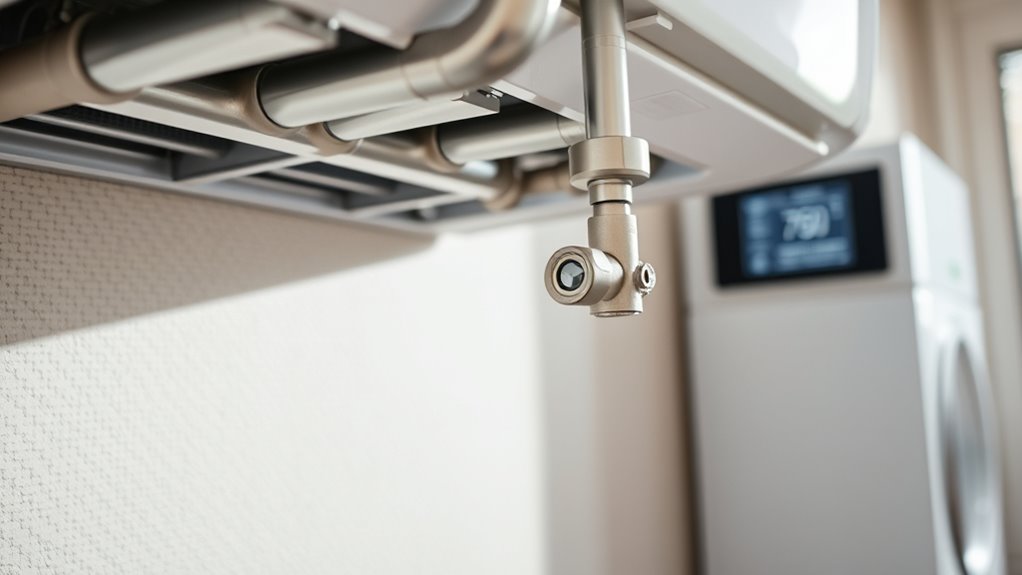
Reversing valves are essential components that enable heat pumps to switch seamlessly between heating and cooling modes, directly impacting humidity control. When in cooling mode, the reversing valve directs refrigerant over cold coils, causing moisture in indoor air to condense and be drained away, aiding dehumidification. Switching to heating mode, the valve reverses the refrigerant flow, stopping condensation as warm air holds more moisture. This controlled reversal ensures the heat pump manages humidity effectively without sacrificing heating performance. Proper functioning of the reversing valve is vital for ideal humidity regulation, especially during warm seasons when moisture removal is needed. Here’s a quick look at how it works:
| Mode | Reversing Valve Action | Effect on Humidity Control |
|---|---|---|
| Cooling | Directs refrigerant over cold coils | Promotes dehumidification |
| Heating | Reverses refrigerant flow | Reduces dehumidification |
| Transitioning | Switches refrigerant direction | Adjusts humidity levels |
| Dehumidification | Active during cooling mode | Removes indoor moisture |
| Comfort | Maintains balanced humidity | Enhances indoor comfort |
Additionally, the reversing valve’s proper operation is closely linked to the overall efficiency and reliability of heat pumps in humidity regulation. Maintaining the correct reversing valve function is essential for consistent performance and long-term durability of the system. Regular inspections and preventative maintenance can help prevent issues and ensure optimal humidity control over the lifespan of the heat pump. Proper system operation is also crucial to prevent potential failures and ensure the heat pump’s longevity.
Differences Between Mini Splits and Ducted Heat Pumps in Dehumidification

Mini splits usually offer better dehumidification because they can target specific zones and remove moisture directly. Ducted heat pumps can do the same, but their efficiency depends on duct design and installation quality. Understanding these differences helps you choose the right system for effective humidity control and space considerations.
Dehumidification Efficiency Differences
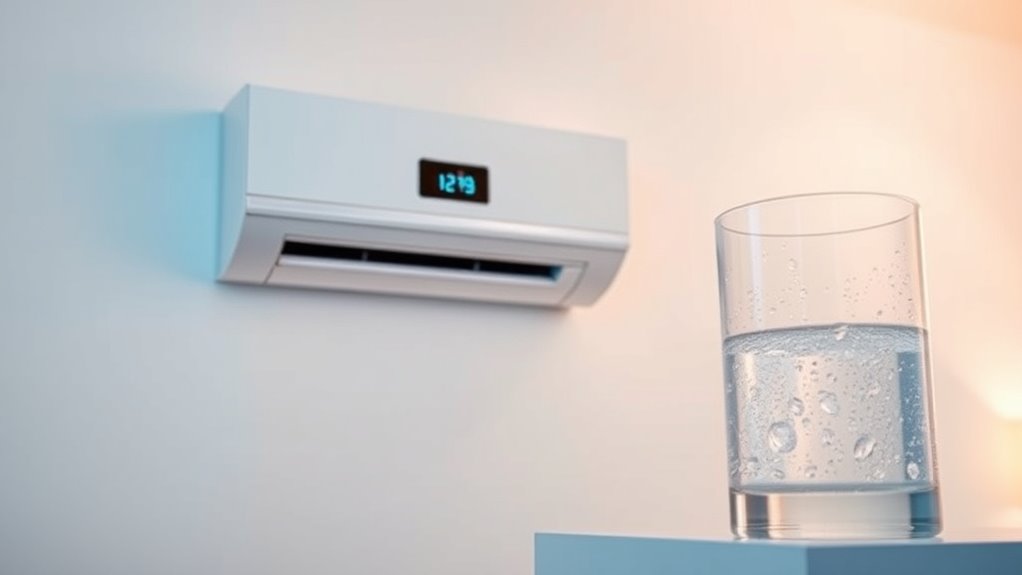
Have you ever wondered why some heat pumps remove more moisture than others? It all comes down to dehumidification efficiency. Mini splits often excel because they feature a dedicated “dry mode,” running the compressor at lower speeds to target moisture removal more effectively. They can operate independently of heating or cooling cycles, allowing for more precise dehumidification. Their design enables direct moisture removal outside the living space, boosting capacity. In contrast, ducted heat pumps rely on ductwork, which can limit dehumidification efficiency and flexibility. Their effectiveness depends on system size, duct design, and whether they have specific dehumidification modes. Overall, mini splits tend to offer superior dehumidification efficiency due to their more targeted operation and design.
Installation and Space Impact
When it comes to dehumidification, the installation setup and space considerations markedly impact system performance. Mini splits are easier to install, often requiring minimal ductwork and fitting into small spaces, which enhances efficiency and zone control. In contrast, ducted heat pumps depend on existing ductwork, which can influence dehumidification uniformity if ducts are poorly designed or sealed. Proper installation of ductwork is vital for ideal moisture removal, affecting overall efficiency. Here’s a comparison:
| Aspect | Mini Split | Ducted Heat Pump |
|---|---|---|
| Installation | Simple, minimal space | More complex, space for ductwork |
| Ductwork | None needed | Essential, can impact efficiency |
| Space Impact | Compact, flexible | Larger footprint, space for ducts |
The Effectiveness of “Dry Mode” in Heat Pumps

“Dry mode” in heat pumps proves to be an effective tool for reducing indoor humidity without substantially impacting temperature. When activated, it runs the air conditioning system’s compressor and fans at lower speeds, maximizing dehumidification. This mode focuses on removing moisture from the air while maintaining indoor temperatures within a narrow range, making it it ideal for high-humidity conditions. Unlike standard cooling, which lowers temperature along with humidity, dry mode prioritizes moisture removal, often without a noticeable temperature drop. Additionally, dry mode consumes less energy than regular cooling or heating modes since it operates at reduced capacity specifically for dehumidification. Its effectiveness depends on the system’s design, outdoor conditions, and indoor humidity levels, but it generally provides reliable moisture control for comfortable indoor environments. SmartCR has highlighted how AI-driven solutions are advancing environmental control technologies, potentially improving the efficiency of dehumidification systems. Furthermore, understanding the resources and tools available can help optimize the overall performance of these systems. For example, the humidity levels in a space significantly influence how well dry mode functions, as optimal humidity control relies on accurate system operation and environmental factors. Also, system design plays a crucial role in how effectively dry mode can maintain desired humidity levels. Modern systems can incorporate smart technology to better adapt to changing conditions and enhance dehumidification performance.
Impact of System Size and Design on Humidity Removal
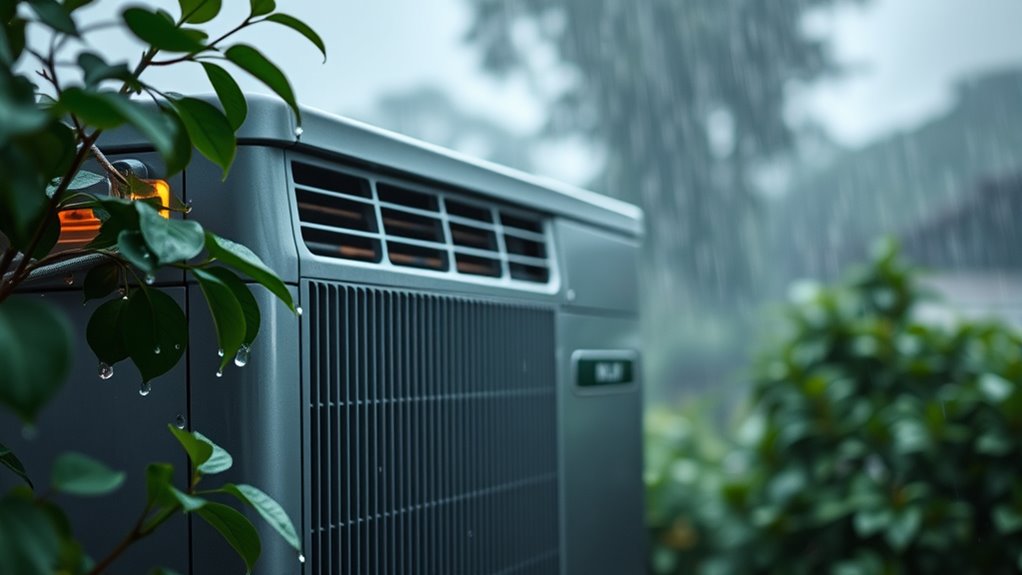
The size and design of a heat pump considerably influence its ability to remove humidity effectively. Properly sized systems with matched indoor coils maximize dehumidification by increasing moisture removal capacity. Oversized units tend to short-cycle, reducing airflow and limiting dehumidification performance. Duct design and insulation are critical; they affect airflow and temperature distribution, which directly impact humidity removal. If airflow is optimized through good duct design, your system can operate efficiently and dehumidify better. Ductless mini splits with zone control can target specific areas for improved humidity management. Additionally, well-sealed ducts prevent humid outdoor air infiltration, supporting more effective dehumidification. Automation technologies can also play a role in monitoring and adjusting humidity levels automatically for optimal comfort. Incorporating smart controls can further enhance system responsiveness and efficiency. Proper system sizing and attention to duct design are essential components in maximizing your heat pump’s dehumidification capabilities.
How Outdoor Conditions Influence Heat Pump Dehumidification
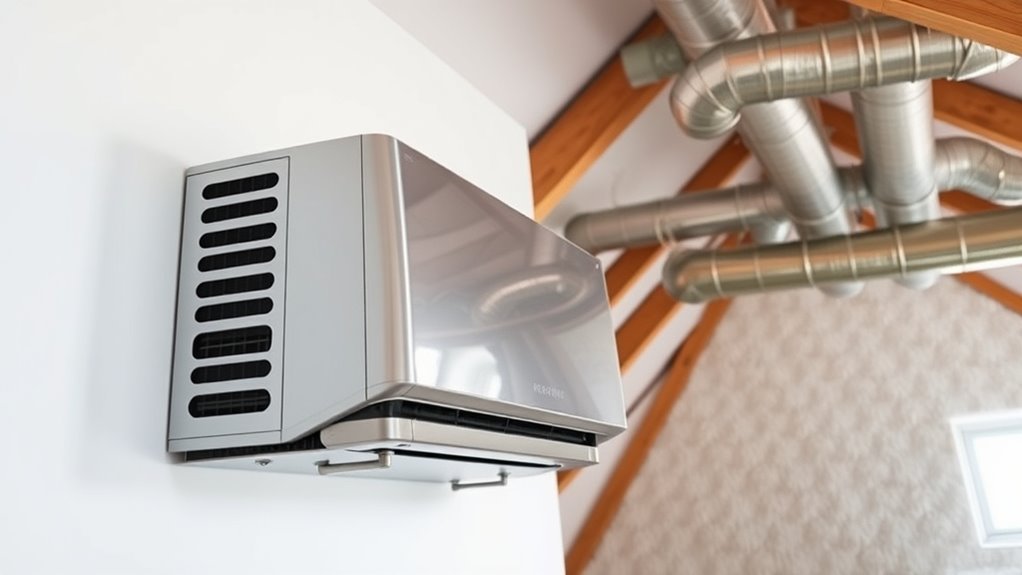
Outdoor conditions play a significant role in how effectively your heat pump can remove indoor humidity. When outdoor temperatures and humidity are high, your heat pump operates in cooling mode, condensing moisture on the cold coil for ideal moisture removal. Conversely, cold outdoor temperatures reduce efficiency and moisture removal because the coils can’t reach low enough temperatures. During winter, heat pumps often switch to heating mode, which doesn’t dehumidify effectively. The table below highlights how different outdoor conditions impact moisture removal: climate considerations are crucial for selecting the right system and settings to maximize efficiency under varying outdoor conditions. Proper system design can also enhance dehumidification, especially in challenging weather conditions. Additionally, understanding dehumidification mechanisms helps homeowners anticipate performance changes across seasons. To optimize energy efficiency, adjusting system settings based on outdoor conditions can improve dehumidification performance year-round. Being aware of seasonal performance variations allows for better control and comfort in your home.
The Importance of Proper Home Insulation and Sealing
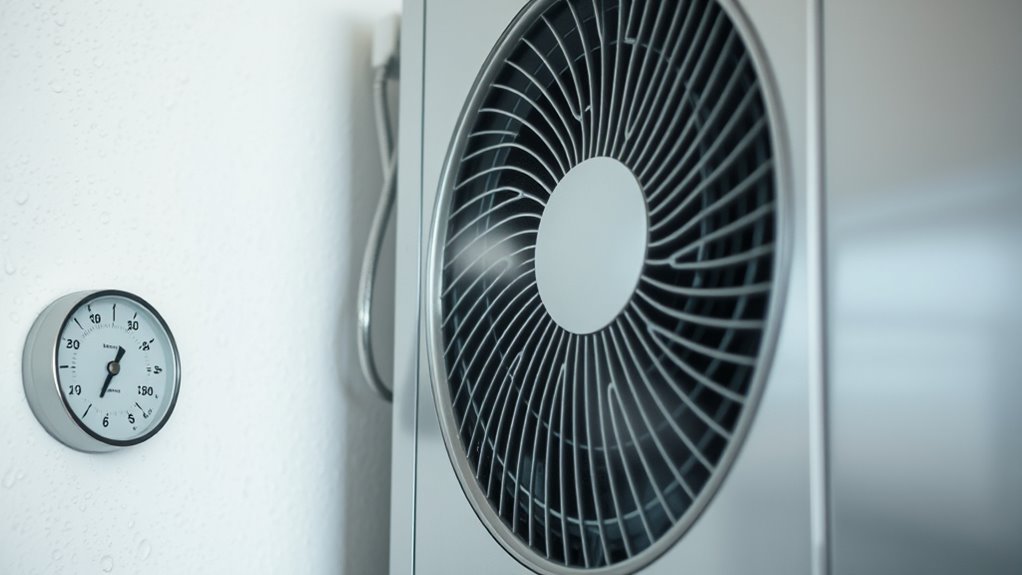
Proper insulation and sealing keep outside moisture from entering your home, helping to control indoor humidity. When your home is well-sealed, your heat pump works more efficiently and uses less energy. Investing in insulation and sealing not only improves comfort but also extends your system’s lifespan. Additionally, maintaining regional bank opening hours can ensure timely service and support for your home improvement projects. Utilizing FAQs related to home insulation and heat pump efficiency can provide helpful insights and tips. Ensuring proper ventilation also plays a key role in maintaining optimal indoor humidity levels and system performance. Incorporating proper sealing techniques can further prevent moisture intrusion and improve overall system efficiency, which contributes to better home decor & design by reducing issues like mold and dampness.
Insulation Prevents Moisture Entry
Effective home insulation acts as a essential barrier that prevents moisture from seeping inside, helping you maintain a healthier indoor environment. Proper insulation limits outdoor moisture entry, reducing humidity levels indoors. Materials like foam, fiberglass, and spray foam create a barrier that blocks moisture infiltration through walls, ceilings, and floors. Sealing gaps around windows, doors, and other leaks enhances this barrier, preventing humid outdoor air from entering. When your home is well-insulated and sealed, it stabilizes indoor humidity, making heat pumps more effective at dehumidification. Proper insulationnot only improves energy efficiency but also contributes significantly to controlling indoor moisture levels. Without proper insulation, moisture easily enters, increasing indoor humidity and making dehumidification efforts harder. Protect your home by ensuring insulation acts as a strong barrier against moisture, keeping your indoor environment comfortable and healthy.
Air Sealing Enhances Efficiency
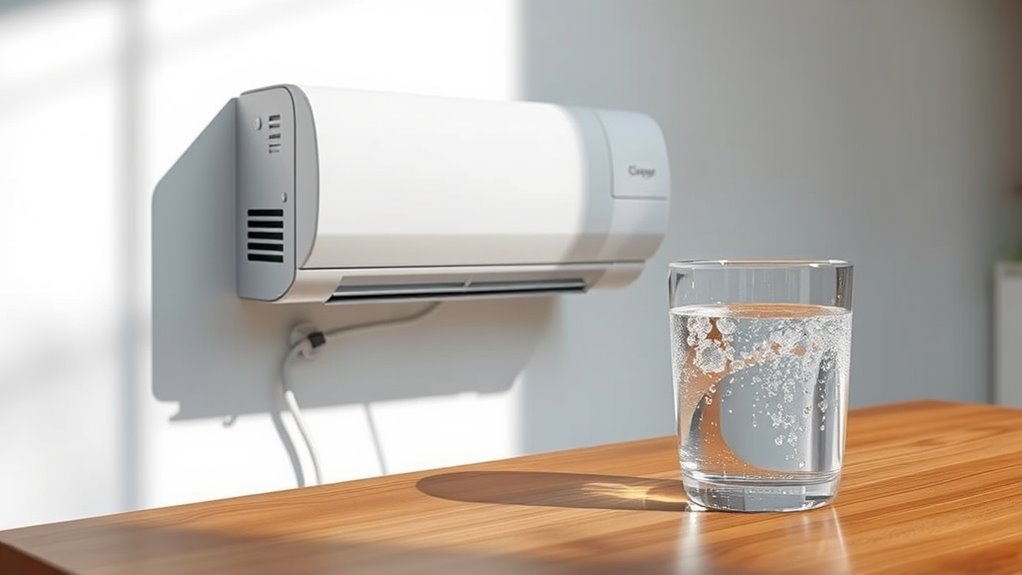
When your home is well-sealed, it prevents drafts and air leaks that can allow humid outdoor air to enter, which in turn reduces the workload on your heat pump’s dehumidification system. Proper air sealing minimizes drafts and air infiltration, helping you maintain consistent indoor humidity levels and boosting overall HVAC efficiency. By sealing gaps and cracks, you prevent outside moisture from entering, making humidity control more effective. Combining air sealing with good insulation reduces the loss of conditioned air—up to 30% in unsealed homes—saving energy and improving comfort. Studies show that sealing leaks and upgrading insulation can cut energy use by up to 50%, allowing your heat pump to operate more efficiently in managing humidity and maintaining ideal indoor air quality.
Reduces Energy Waste
Sealing gaps and adding insulation considerably cut down on energy waste by stopping unwanted heat transfer and air leaks. When your home is properly insulated and sealed, your HVAC system, including heat pumps, can work more efficiently to dehumidify and regulate moisture levels. Without air sealing, outside humidity and temperature fluctuations cause your system to run longer, wasting energy. Proper insulation also maintains stable indoor temperatures, reducing unnecessary system runtime. This improved energy efficiency lowers utility bills and extends your HVAC’s lifespan.
Here are key benefits:
- Minimizes heat transfer and air leaks
- Enhances dehumidification and moisture control
- Reduces strain on HVAC systems
- Boosts overall energy efficiency
Common Reasons a Heat Pump Might Not Dehumidify Effectively
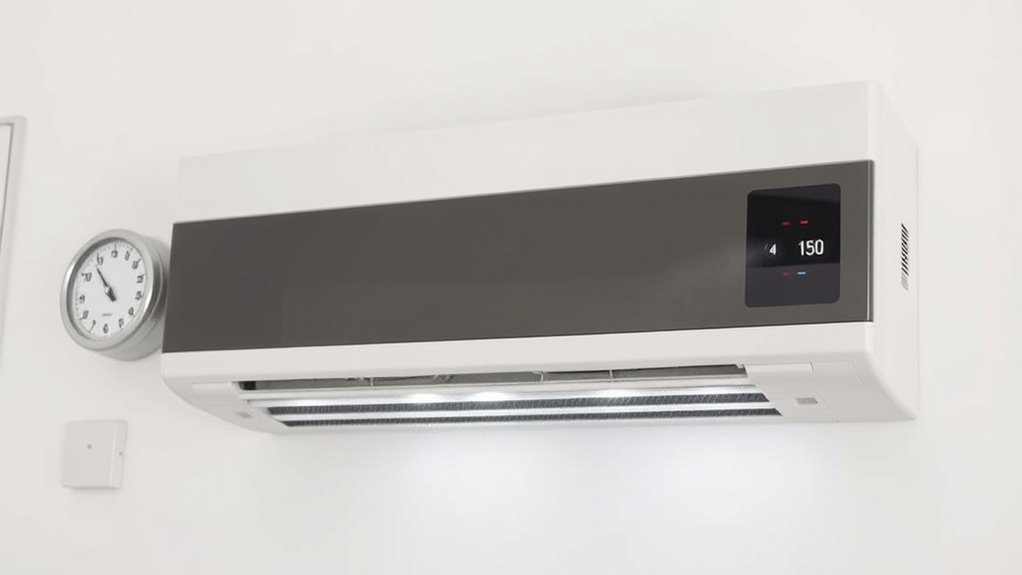
A common reason your heat pump might struggle to dehumidify is a dirty or corroded evaporator coil, which hampers its ability to condense moisture from the air. When the coil is clogged, airflow decreases, reducing humidification efficiency and causing the system to cycle frequently. This rapid cycling prevents the heat pump from maintaining consistent dehumidification, as it turns on and off prematurely. Additionally, a malfunctioning component, such as a sensor or control system, can prevent the unit from activating the dehumidification mode altogether. Improper sizing of the indoor coil can also contribute, leading to inefficient operation and inconsistent moisture removal. Addressing these issues ensures your heat pump performs effectively, maintaining ideal humidity levels in your home.
Comparing Heat Pump Dehumidification to Dedicated Dehumidifiers
Heat pumps remove humidity by cooling air and condensing moisture on their coils during regular operation, which can help maintain comfortable indoor conditions. However, dedicated dehumidifiers generally provide higher moisture removal capacity, making them more effective in very humid environments. When comparing the two:
Heat pumps help control humidity, but dedicated dehumidifiers remove moisture more efficiently in high-humidity settings.
- Heat pumps dehumidify as part of cooling cycles, suitable for moderate humidity levels.
- Dedicated dehumidifiers are designed solely for moisture removal, offering higher capacity.
- Heat pumps with “dry mode” provide targeted dehumidification but are limited in capacity.
- Combining a heat pump with a dedicated dehumidifier can optimize moisture removal when needed.
While heat pumps handle moderate dehumidification needs well, dedicated dehumidifiers excel in achieving lower humidity levels, especially in high humidity conditions.
Tips for Maximizing Your Heat Pump’s Moisture Removal Capabilities
To get the most out of your heat pump’s moisture removal, start by keeping the coils clean and free of debris. Use the “dry mode” or dehumidification setting when humidity is high, and seal leaks around your home to prevent outside moisture from entering. These simple steps help your system operate efficiently and maximize dehumidification.
Maintain Clean Coils
Keeping your coils clean is essential for maximizing your heat pump’s ability to remove moisture from the air. Dirt, dust, and mold on the coils hinder heat transfer, reducing dehumidification performance. Regular cleaning ensures unobstructed airflow, improves moisture condensation, and maintains efficient operation. Schedule professional inspections and cleanings at least once a year to prevent buildup that can impair moisture removal. Also, check refrigerant levels and fix leaks to keep coils operating at their best. Using coil cleaners or degreasers designed for heat pumps can effectively remove debris and boost moisture-condensing capacity.
Tips for maintaining clean coils:
- Regularly replace or clean air filters.
- Schedule professional coil inspections annually.
- Use appropriate coil cleaning products.
- Check refrigerant levels and repair leaks.
Use Dry Mode
Using dry mode can substantially boost your heat pump’s ability to remove excess moisture, especially during humid seasons. This setting enhances dehumidification by running the compressor at low speeds and reducing fan noise, which helps control indoor humidity without changing your temperature preferences. To maximize moisture removal, guarantee your heat pump is well-maintained, with clean filters and coils, as this improves dehumidification efficiency. Running dry mode during peak humidity hours, like late afternoon or early evening, can prevent mold growth and keep moisture levels in check. Regularly monitor indoor humidity with a hygrometer to determine if consistent use of dry mode is necessary. Proper use of this setting gives you better humidity control and a more comfortable, mold-free environment.
Seal Home Leaks
Did you know that sealing home leaks can considerably boost your heat pump’s ability to remove excess moisture? When you seal leaks, you prevent outside humid air from entering, reducing moisture ingress and helping your heat pump maintain ideal indoor humidity. Gaps around doors, windows, and ductwork are common sources of moisture ingress that make dehumidification harder. Properly sealing these leaks improves efficiency by limiting external humidity sources. To maximize moisture removal, consider:
- Applying weatherstripping around doors and windows
- Caulking gaps in window and door frames
- Sealing ductwork with appropriate tape or mastic
- Insulating and sealing attic and basement openings
These steps help your heat pump operate more efficiently and effectively, ensuring a drier, more comfortable indoor environment.
Frequently Asked Questions
How Effective Are Heat Pumps at Dehumidifying?
You might wonder how well heat pumps dehumidify your space. They’re quite effective, removing up to 15 gallons of moisture daily during peak cooling times. When in cooling mode, they condense moisture on the coil and drain it away, reducing humidity. Some models even have a “dry mode” for better dehumidification without extra cooling, helping you maintain comfortable indoor humidity levels of 50-55%.
Can a Heat Pump Dehumidify Without Cooling?
You ask if a heat pump can dehumidify without cooling. Generally, the answer is yes, but it depends on your system. Many models have a “dry mode” or dehumidification setting that removes moisture without cooling or heating the air. However, during heating mode or cold outdoor temperatures, dehumidification is limited because the system isn’t designed to condense moisture then. Check if your heat pump has specific dehumidification features.
How Do You Dehumidify a House With a Heat Pump?
Ever wonder how to make your home less humid with a heat pump? It’s simpler than you think. You just set your system to cooling mode or dry mode, which actively pulls moisture from the air. Make sure your unit is properly sized and maintained for maximum efficiency. Good air circulation and outdoor conditions also matter. With these steps, you’ll keep your home comfortably dry and cozy.
Can You Control Humidity With Heat Pump?
You can control humidity with a heat pump by using its cooling cycle, which condenses moisture from the air. Many models have a “dry mode” that actively reduces humidity without changing the temperature. To keep indoor humidity ideal, regularly maintain your system and guarantee it’s properly sized. Keep in mind, humidity control is most effective in warm weather, while winter limits moisture removal due to cold outdoor air.
Conclusion
By understanding how your heat pump manages humidity, you can unseal its full dehumidification potential. From system design to insulation, every detail matters in keeping your home dry and comfortable. When functioning properly, your heat pump can be more powerful than a hurricane at removing moisture—truly a superhero in disguise. Stay proactive with maintenance and settings, and you’ll enjoy a home so dry, it’s like the Sahara turned into a desert oasis!






